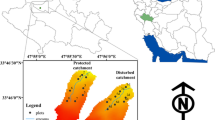Abstract
The purpose of this study was to analyze the propriety of establishing riparian greenspace for watersheds of four major rivers in South Korea and suggest strategies for improving the analyzed problems. Growth environments, vegetation structures, planting techniques, and tree growth and management conditions were analyzed targeting 45 sites. Soils at the sites had organic matter of 1.3 % and cation exchange capacity of 4.4 cmol+/kg, which are poor conditions for tree growth. A tree diameter at breast height of <7 cm accounted for 77 % of all trees planted, and mean tree cover was only 28 % due to planting of mainly small trees. Planting techniques were represented by single-layered planting (84 %) consisting of a single species or a few species in similar size. Approximately 11 % of all planted trees withered, and many trees had poor growth. The growth ratios for shoot and leaf length in planted trees compared with normally growing trees were 57 and 77 %, respectively. Oppression by invasion of herbaceous and climbing plants associated with negligent maintenance hindered normal tree growth at some sites. Strategies to improve these problems and promote the function of riparian greenspaces suggest securing a minimum width and connectivity of greenspace, analyzing growth ground prior to planting, improving the soil environment, woodchip mulching on ground surfaces, middle/high density plantings mixed with fast-growing trees, edge planting to protect internal growth environment, and multilayered and grouped ecological planting reflecting natural riparian forest structures.






Similar content being viewed by others
References
Binford MW, Karty RJ (2006) Riparian greenways and water resources. In: Hellmund PC, Smith DS (eds) Designing greenways. Island Press, Washington, DC, pp 108–157
Buffler S (2005) Synthesis of design guidelines and experimental data for water quality function in agricultural landscapes in the Intermountain West. Master’s thesis. Utah State University, Logan, UT
CAER (Center for Aquatic Ecosystem Restoration) (2010) Development of technology to recreate riverine forests and eco-belts. Research Report II. Chuncheon
JFRWEM (Japan Foundation of River & Watershed Environment Management) (2001) Guidelines for planning and management of riparian forest corridors along river levee. Yamamido, Tokyo
Jo HK (2002) Impacts of urban greenspace on offsetting carbon emissions for middle Korea. J Environ Manage 64:115–126
Jo HK, Ahn TW (2006) Structural conditions of greenspace in a rural region and strategies for its functional improvement. Korean J Environ Ecol 20(4):493–502
Jo HK, Ahn TW (2012) Landscape preferences for greenspace structures. J For Sci 28(1):56–62
Jo HK, Kim JY, Park HM (2013) Monitoring tree growth and propriety after riparian greenspace establishment. Proc Korean Soc Environ Ecol Conf 23(1):55
Johnson CW, Buffler S (2008) Riparian buffer design guidelines for water quality and wildlife habitat functions on agricultural landscapes in the Intermountain West. Gen Tech Rep RMRS-GTR-203. USDA Forest Service, Rocky Mountain Research Station, Fort Collins, CO
KEI (Korea Environment Institute) (2000) A study on establishment and management of riparian greenspace for water quality improvement. KEI-RE-2000-12. Seoul
KEI (Korea Environment Institute) (2001) A study on establishment and management of riparian buffers in urban areas. KEI-RE-2001-05. Seoul
Ki KS, Kim JY (2012) Monitoring of plant community structure change for four years (2007–2010) after riparian ecological restoration, Nakdong River. Korean J Environ Ecol 26(5):707–718
KIAST (Korean Institute of Agricultural Science & Technology) (2000) Methods of analysis for soils and plants. Suwon
KILA (Korean Institute of Landscape Architecture) (2007) Landscape design criteria. Kimoondang, Seoul
KWRC (Korea Water Resources Corporation) (2005) Guidelines for establishment and management of riparian forest buffers. SP 58730-2005-2. Daejeon
Lee SW (1981) Studies on forest soils in Korea (II). J Korean For Soc 54:25–35
Lee P, Smyth C, Boutin S (2004) Quantitative review of riparian buffer width guidelines from Canada and the United States. J Environ Manage 70:165–180
McPherson EG, Nowak D, Heisler G, Grimmond S, Souch C, Grant R, Rowntree R (1997) Quantifying urban forest structure, function, and value. Urban Ecosystems 1:49–61
Miller RW (1997) Urban forestry: planning and managing urban greenspaces. Prentice Hall, Upper Saddle River
Noss RF (2006) Greenways as wildlife corridors. In: Hellmund PC, Smith DS (eds) Designing greenways. Island Press, Washington, DC, pp 70–107
Peterjohn WT, Correll DL (1984) Nutrient dynamics in an agricultural watershed: observations on the role of a riparian forest. Ecology 65:1466–1475
Ranney JW, Bruner MC, Levenson JB (1981) The importance of edge in the structure and dynamics of forest islands. In: Burgess RL, Sharpe DM (eds) Forest island dynamics in man-dominated landscapes. Springer, New York, pp 67–95
Smith DS (1993) An overview of greenways: their history, ecological context, and specific functions. In: Smith DS, Hellmund PC (eds) Ecology of greenways. University of Minnesota Press, Minneapolis, pp 1–22
Tassone JE (1981) Utility of hardwood leave strips for breeding birds in Virginia’s central piedmont. Master’s thesis. Virginia Polytechnic Institute and State College, Blacksburg, VA
Tewksbury JJ et al (2002) Corridors affect plants, animals, and their interactions in fragmented landscapes. Proc Natl Acad Sci USA 99:12923–12926
Acknowledgments
This study was supported by the CAER (Center for Aquatic Ecosystem Restoration) of Eco-STAR project (07-III-8) from MOE (Ministry of Environment, Republic of Korea).
Author information
Authors and Affiliations
Corresponding author
Rights and permissions
About this article
Cite this article
Jo, HK., Ahn, TW. & Son, C. Improving riparian greenspace established in river watersheds. Paddy Water Environ 12 (Suppl 1), 113–123 (2014). https://doi.org/10.1007/s10333-014-0436-0
Received:
Revised:
Accepted:
Published:
Issue Date:
DOI: https://doi.org/10.1007/s10333-014-0436-0




